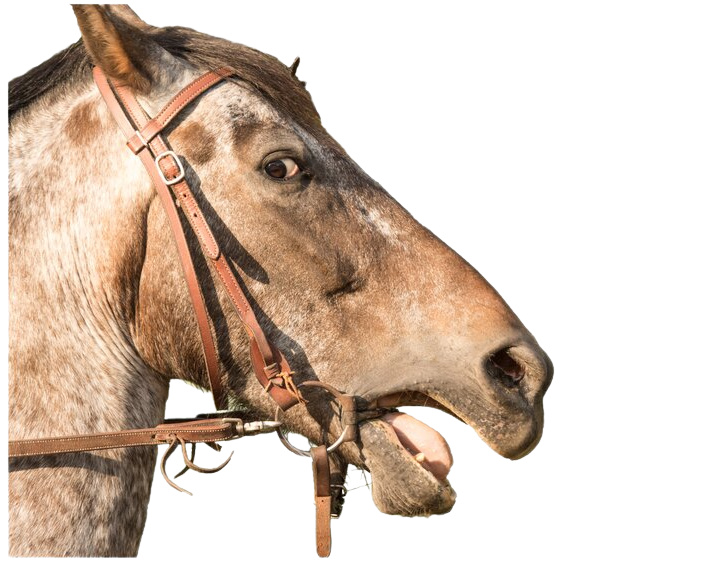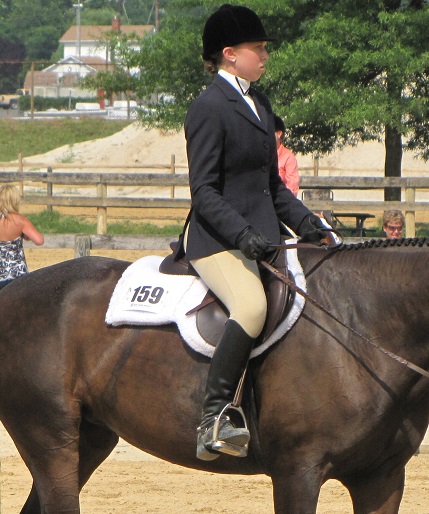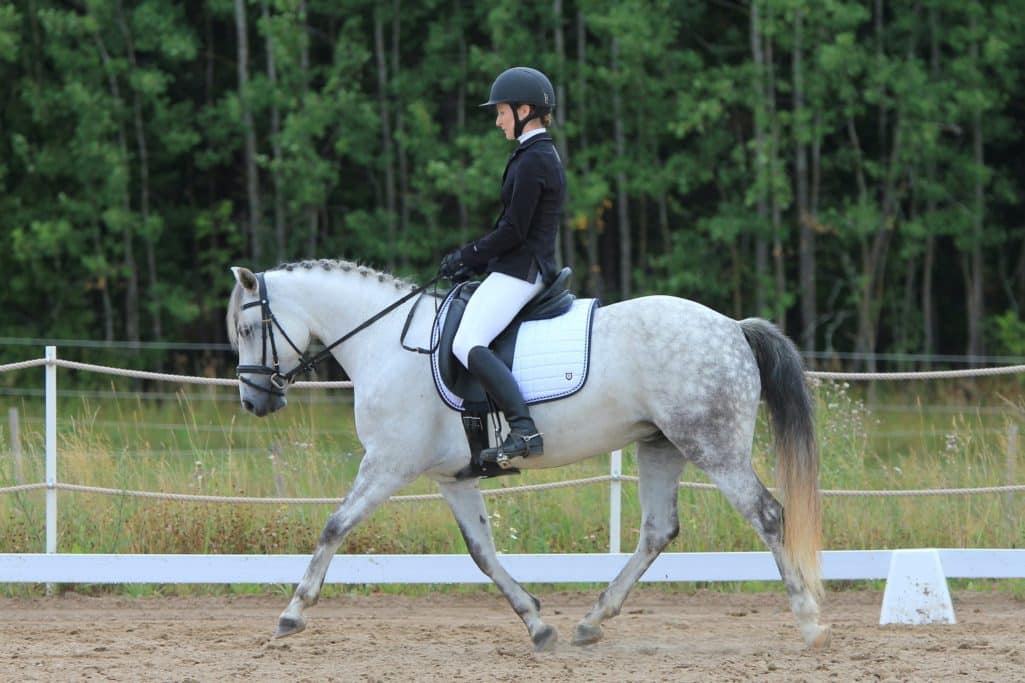Special Note: Hello, I started writing this post with the technical description of the balanced rider, riding the “Center of Balance,” and the “Center of Gravity” of a horse. I reminded myself that this blog is for learning to ride for beginner riders, and if a child, their parents. So they can learn with simple words and simple explanations.
In this series of posts, I pictured a beginner’s first lesson. Of course, I never want to overwhelm a new rider. However, as a rider advances to the next level in their riding, their abilities and skills allow them to understand the mechanics and technicalities of balance better.
I will end this three-part series on balance with horse riding exercises to improve balance.
This post is a continuation of the previous conversation about rider and horse balance. https://newtohorses.com/riding-skills-why-is-balance-so-important/

Learning to be a balanced rider is essential for staying on the horse when it moves its body.
Eventually, balance will come naturally, like riding a bike and swimming. Muscle memory plays a significant part in obtaining balance on a horse. Multiple parts of the body learn how to keep your body in balance. The brain plays an important role, too, by telling the body parts how to work. As the horse moves during different gaits and other movements, proper balance will create a safe and smooth ride for both rider and horse.
For a beginner rider, I typically teach that the horse’s center of balance sets on the area just behind the saddle’s pommel, which should be the base of the withers. See the above illustration. As the beginner advances in their riding, they may pick a discipline that changes the center of balance more forward or towards the rear.
In part three of this post, “Riding skills: It’s essential to relax to find your balance, part 3” I include horse riding exercises for beginners. No matter the age, these exercises benefit a new rider.
Children usually lack fear, or at the least, their fear factor is less than adults.
Unlike adults, kids have less “fear factor.” As a result, it seems easier and faster for a child to find balance.
When riders are fearful, they tighten up their bodies and become stiff or rigid. A stiff rider does not naturally connect with the horse and finds balance.
Most kids usually don’t get rigid, but they grab onto anything they can find until they can settle in and relax, including the reins connected to the bit.
Many exercises and riding aids (see below) help scared riders improve their confidence. Once they are comfortable being on top of a horse, they can find a better balance. All riders of many levels and ages benefit from simple exercises. And the activities can be fun!
Riders may need help with a couple of tools
If a beginner rider finds it hard to balance, a neck grab strap or pommel strap can give them something to grab that won’t hurt the horse. Below the first and second box is the pommel strap that hooks onto the saddle’s pommel on the rings shaped like a D. The next box is a neck grab strap. It fits around the horses neck that give them something to hold when they feel unbalanced.
Make sure the rider can easily reach this riding tool with their hand (s). Eventually these tools will not be necessary.
Using the above pommel straps can help keep a rider feel safe and possibly help eliminate a fall. These tools are not meant to be a crutch, and a good instructor will know how to wean the new rider from using the straps all the time. However, knowing they are there can be confidence builder, by adding a bit of confidence to their first rides.
Stiffness in a rider’s body equals discomfort for the horse and the rider.
Not a guarantee but, the above straps can help prevent a fall.
Stiffness can be uncomfortable for the horse and the rider. In both instances, a rider’s impact with the saddle can cause discomfort. Below are a few examples of how a rider’s un-balance can cause a fall or hurt the horse.
If the rider is stiff and the horse is trotting, the rider’s body will come straight up and out of the saddle. Then, it lands back down onto the saddle with all the rider’s weight. The rider does not rebound smoothly because their body is stiff when they land. Instead, it jolts up and down. Similar to a basketball being dribbled. When the rider falls back down onto the saddle because they are unbalanced, their upper body weight usually falls towards the right or left. Next comes the fall off the horse.
Riders that lack balance may also squeeze too hard with their legs in an attempt to feel secure. The intense squeezing against their horse’s sides could put the horse into a panic or, at the least, make him move faster than expected.
When the horse is trying to find relief from the rider’s legs, the horse may lunge forward as they are trying to find relief. The lunge forward reaction makes a rider fall backward onto the horse’s croup, part of the back just behind the saddle. Their legs raise, and they roll-off. A rider who has been taught what a pommel strap is for could use the strap to prevent a fall.
Another reaction to a horse lunging forward might be a rider pulling the reins in the attempt to pull themself back up into the saddle. As a result, the reaction makes it very uncomfortable and sometimes painful for the horse’s mouth. (reins are the part of the bridle that connects the rider’s hand to the horse’s mouth or nose)
There are times when an out-of-balance rider may roll their shoulders forward and bring their legs up. They end up in the “fetal position.” They rolled up in a ball, like a baby in the womb, or the shape in a forward somersault. Balls roll, hence the rider rolls off either side of the horse.
The above are a few ways a fall can happen. Many scenarios, but most riders can prevent a fall within seconds with a balanced rider.
A horses mouth should be a no touch zone for beginner riders
My riders didn’t even use reins in their first few lessons. A horse’s mouth is a “no-touch” zone for beginners. My number one rule is that you NEVER jerk your horse’s mouth. Using the reins and bit roughly is abuse and should never be seen at any time. Reins and bits are connected to the bridle and used to communicate kindly with your horse.



Most lesson horses understand the rare jerk or strong pull from a beginner. But the best way to “ruin” a horse is to pull on its mouth at the wrong times and be overly heavy-handed by pulling harder than needed. Like when turning or stopping a horse harshly. Instead, a rider must learn to balance and use a soft, educated hand.
All level riders should never use the horse’s mouth to recover when losing their balance. It could cause the horse to bolt, rear, turn sharply, which could cause physical damage to the horse or rider.
Being a balanced rider comes with patience, confidence, proper practice, and muscle memory!!

www.newtohorses.com
I started to title this paragraph “balance comes with practice and hard work,” but it’s not hard—the same as when you learn to ride a bike. You keep trying and practicing until you get your balance, relax and trust yourself enough to take the training wheels off. In this case, take your hands away from the neck or strap. Perfect Practice teaches our body the correct position, and muscle memory takes over.
Naturally talented riders get it.
A “Talented” rider finds riding natural and easy. They obtain good position skills immediately. They have no fear and become relaxed and connected with the horse physically and mentally quicker than others.
Some new riders find riding very easy and natural. Those riders that don’t find it natural need to work harder at finding balance and comfort. But, it can be found and maintained. Most riders that really enjoy horses and want to learn to ride are willing to put in the time and do the exercises in order to create a great partnership, with physical and emotional connection.
First comes balance. Next is rhythm.
When finally in balance, a rider can feel a horse’s rhythm or the beat of the horse’s hoof as it hits the ground. As a result, the rider can then ride with the horse’s rhythm. This is when both balance and rhythm become a harmonious connection between horse and rider.
Although the rhythm of a horse’s rhythm is a big part of learning to ride. To truly be harmonious with the horse. The rider needs to be able to balance first.
The next post will be about horse riding exercises to improve balance
Link coming soon
Thanks for reading my blog, I hope it has been helpful and enjoyable. Please feel free to ask me questions or suggest a topic. Also, join us on Facebook and Instagram.

